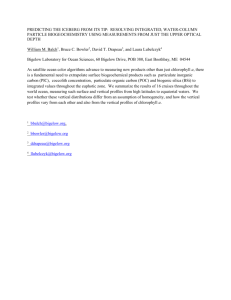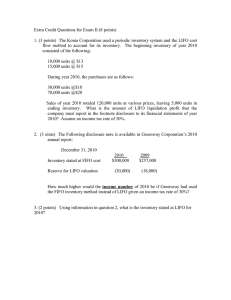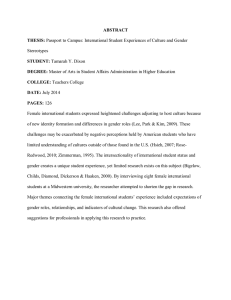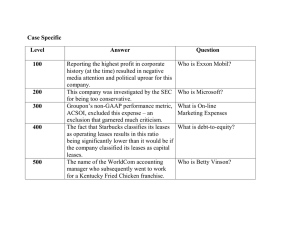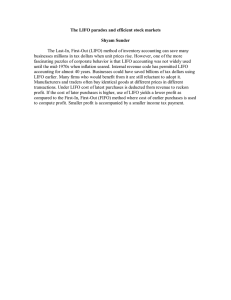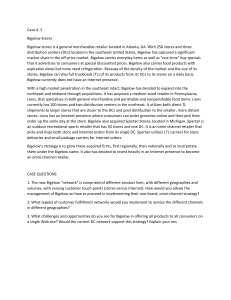15.501/516 Problem Set 4
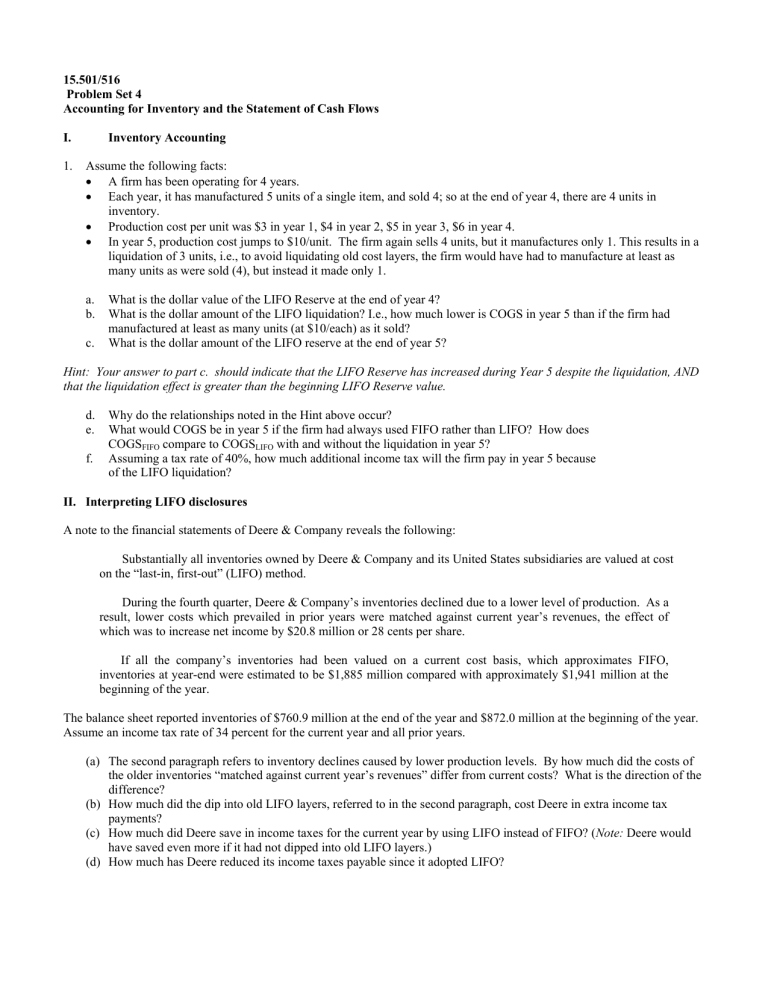
15.501/516
Problem Set 4
Accounting for Inventory and the Statement of Cash Flows
I. Inventory
1. Assume the following facts:
• A firm has been operating for 4 years.
• Each year, it has manufactured 5 units of a single item, and sold 4; so at the end of year 4, there are 4 units in inventory.
• Production cost per unit was $3 in year 1, $4 in year 2, $5 in year 3, $6 in year 4.
• In year 5, production cost jumps to $10/unit. The firm again sells 4 units, but it manufactures only 1. This results in a liquidation of 3 units, i.e., to avoid liquidating old cost layers, the firm would have had to manufacture at least as many units as were sold (4), but instead it made only 1. a. What is the dollar value of the LIFO Reserve at the end of year 4? b. What is the dollar amount of the LIFO liquidation? I.e., how much lower is COGS in year 5 than if the firm had manufactured at least as many units (at $10/each) as it sold? c. What is the dollar amount of the LIFO reserve at the end of year 5?
Hint: Your answer to part c. should indicate that the LIFO Reserve has increased during Year 5 despite the liquidation, AND that the liquidation effect is greater than the beginning LIFO Reserve value. d. Why do the relationships noted in the Hint above occur? e. What would COGS be in year 5 if the firm had always used FIFO rather than LIFO? How does
COGS
F IFO
compare to COGS
L IFO
with and without the liquidation in year 5? f. Assuming a tax rate of 40%, how much additional income tax will the firm pay in year 5 because of the LIFO liquidation?
II. Interpreting LIFO disclosures
A note to the financial statements of Deere & Company reveals the following:
Substantially all inventories owned by Deere & Company and it s United States subsidiaries are valued at cost on the “last-in, first-out” (LIFO) method.
During the fourth quarter, Deere & Company’s inventories declined due to a lower level of production. As a result, lower costs which prevailed in prior years were matched against current year’s revenues, the effect of which was to increase net income by $20.8 million or 28 cents per share.
If all the company’s inventories had been valued on a current cost basis, which approximates FIFO, inventories at year-end were estimated to be $1,885 million compared with approximately $1,941 million at the beginning of the year.
The balance sheet reported inventories of $760.9 million at the end of the year and $872.0 million at the beginning of the year.
Assume an income tax rate of 34 percent for the current year and all prior years.
(a) The second paragraph refers to inventory declines caused by lower production levels. By how much did the costs of the older inventories “matched against current year’s revenues” differ from current costs? What is the direction of the difference?
(b) How much did the dip into old LIFO layers, referred to in the second paragraph, cost Deere in extra income tax payments?
(c) How much did Deere save in income taxes for the current year by using LIFO instead of FIFO? ( Note: Deere would have saved even more if it had not dipped into old LIFO layers.)
(d) How much has Deere reduced its income taxes payable since it adopted LIFO?
III. Preparing the Statement of Cash Flows
5. Bigelow Electronics began operations in 1998, selling and servicing specialized video equipment. During the course of that year, Bigelow acquired 700 units of Model XL-535 for $320 each and 400 units of Model XD-685 for $475 each. By the end of 1998, the company had sold 516 of the Model XL-535 units and 284 of the model XD-685 units.
On Jan. 1, 1999, Bigelow's supplier increased the prices of these two models to $335 and $495, respectively. Over the course of the year, Bigelow purchased 1,200 additional units of Model XL-535 and 850 more units of Model XD-685 at the new higher prices. Bigelow's 1999 sales amounted to 1,126 and 739 of the two products, respectively, for total gross sales revenue of $1,234,255. Bigelow uses the FIFO (first-in, first-out) cost flow assumption to value its inventory. Physical inventory counts at the end of each year reveal that no merchandise has been lost or stolen.
Since Bigelow's customers are primarily small businesses, 60% of the company's sales in each of the first two years were made on credit. Based on his experience with his previous employer, Bigelow's sales manager estimated that 5% of 1998's credit sales would not be collected. During 1999, the company wrote off specific accounts receivable totaling $25,270. Writeoffs during 1998 amounted to $10,240.
While Bigelow Electronics does not allow customers to return products, the company does offer a 12-month warranty on parts and labor. The sales manager has estimated that the costs of fulfilling these warranties will amount to 2% of the products' gross revenues. During 1999, the company incurred $18,525 in actual warranty costs.
The company pays salaries on the last day of each month for the services rendered during that month. On the 20 th of each month, Bigelow pays the rent due on its storefront location for the following month. Through December 1999, rent has been
$4,300/month, but it is increasing to $4,500/month on January 1, 2000. Bigelow faces an income tax rate of 40 percent, and makes one annual tax payment 30 days after the fiscal year ends. To date, the company has not declared dividends.
Required: a. Compute the missing numbers for the attached balance sheets and income statements for Bigelow Electronics. Briefly explain your rationale for each calculation. (Label each explanation as to the line item and year it represents.) b. Using the indirect approach, prepare the operations section of a statement of cash flows (SCF) for FY1999. Briefly explain how Bigelow's cash balance fell compared to the balance at December 31, 1998 despite the healthy profit that the company reported for FY1999. c. Assume that Bigelow used the LIFO (last in, first out) cost flow assumption rather than FIFO for both years. Indicate which numbers in the 1999 financial statements would be affected by this change, then recompute those numbers only and explain your calculations. d. Comment on Bigelow Electronics' financial condition (particularly its liquidity) as of 12/31/99.
Bigelow Electronics
Balance Sheets for Years ending December 31
12/31/99 12/31/98
Assets
Cash ________
Accounts Receivable, net
Inventory
85,695 41,272
Prepaid Rent ________ 4,300
Liabilities and Shareholders' Equity
Accounts Payable
Taxes Payable
Accrued Warranty Liability
Total Liabilities
68,560 43,620
________ 418
________ 4,710
116,109 ________
Total Liabilities and Shareholders' Equity $296,762 ________
Income Statements months months
ending ending
12/31/99 12/31/98
Net Sales Revenue
Less: Cost of goods sold
Salary expense
$1,196,980 $ 501,684
__________ __________
267,500 151,600
Rent expense
Warranty expense
Other operating expenses
Net income before taxes
Tax expense
Net income after taxes
51,600 34,400
__________ __________
23,555 4,275
__________ __________
__________ __________
__________ __________
Courtesy of U.S. Securities and Exchange Commission. Used with permission.
1
2
Net of Allowance for Uncollectible Accounts of ________ and $5,276 for 1999 and 1998, respectively.
3
